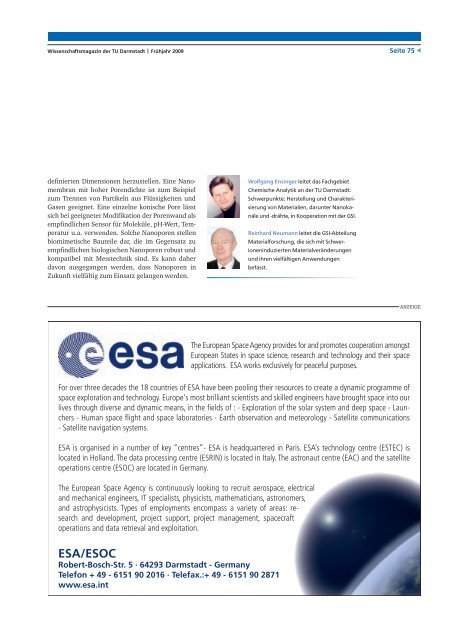forschen 1/2009 - Forschungscluster «Nuclear and Radiation Science
forschen 1/2009 - Forschungscluster «Nuclear and Radiation Science
forschen 1/2009 - Forschungscluster «Nuclear and Radiation Science
Erfolgreiche ePaper selbst erstellen
Machen Sie aus Ihren PDF Publikationen ein blätterbares Flipbook mit unserer einzigartigen Google optimierten e-Paper Software.
Wissenschaftsmagazin der TU Darmstadt | Frühjahr <strong>2009</strong><br />
definierten Dimensionen herzustellen. Eine Nanomembran<br />
mit hoher Porendichte ist zum Beispiel<br />
zum Trennen von Partikeln aus Flüssigkeiten und<br />
Gasen geeignet. Eine einzelne konische Pore lässt<br />
sich bei geeigneter Modifikation der Porenw<strong>and</strong> als<br />
empfindlichen Sensor für Moleküle, pH-Wert, Temperatur<br />
u.a. verwenden. Solche Nanoporen stellen<br />
biomimetische Bauteile dar, die im Gegensatz zu<br />
empfindlichen biologischen Nanoporen robust und<br />
kompatibel mit Messtechnik sind. Es kann daher<br />
davon ausgegangen werden, dass Nanoporen in<br />
Zukunft vielfältig zum Einsatz gelangen werden.<br />
Seite 75 ◀<br />
The European Space Agency provides for <strong>and</strong> promotes cooperation amongst<br />
European States in space science, research <strong>and</strong> technology <strong>and</strong> their space<br />
applications. ESA works exclusively for peaceful purposes.<br />
For over three decades the 18 countries of ESA have been pooling their resources to create a dynamic programme of<br />
space exploration <strong>and</strong> technology. Europe‘s most brilliant scientists <strong>and</strong> skilled engineers have brought space into our<br />
lives through diverse <strong>and</strong> dynamic means, in the fi elds of : - Exploration of the solar system <strong>and</strong> deep space - Launchers<br />
- Human space fl ight <strong>and</strong> space laboratories - Earth observation <strong>and</strong> meteorology - Satellite communications<br />
- Satellite navigation systems.<br />
ESA is organised in a number of key “centres”- ESA is headquartered in Paris. ESA’s technology centre (ESTEC) is<br />
located in Holl<strong>and</strong>. The data processing centre (ESRIN) is located in Italy. The astronaut centre (EAC) <strong>and</strong> the satellite<br />
operations centre (ESOC) are located in Germany.<br />
The European Space Agency is continuously looking to recruit aerospace, electrical<br />
<strong>and</strong> mechanical engineers, IT specialists, physicists, mathematicians, astronomers,<br />
<strong>and</strong> astrophysicists. Types of employments encompass a variety of areas: research<br />
<strong>and</strong> development, project support, project management, spacecraft<br />
operations <strong>and</strong> data retrieval <strong>and</strong> exploitation.<br />
ESA/ESOC<br />
Robert-Bosch-Str. 5 · 64293 Darmstadt - Germany<br />
Telefon + 49 - 6151 90 2016 · Telefax.:+ 49 - 6151 90 2871<br />
www.esa.int<br />
Wolfgang Ensinger leitet das Fachgebiet<br />
Chemische Analytik an der TU Darmstadt.<br />
Schwerpunkte: Herstellung und Charakterisierung<br />
von Materialien, darunter Nanokanäle<br />
und -drähte, in Kooperation mit der GSI.<br />
Reinhard Neumann leitet die GSI-Abteilung<br />
Materialforschung, die sich mit Schwerioneninduzierten<br />
Materialveränderungen<br />
und ihren vielfältigen Anwendungen<br />
befasst.<br />
ANZEIGE


